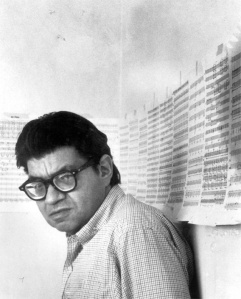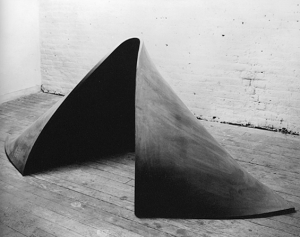 Looking back beyond the ’60s and reflecting on the art scene in New York, Morton Feldman produced one of his most memorable and characteristic essays — “Give My Regards to Eighth Street”. It was written in 1971, in the wake of pop art, specific objects, and minimalism. The artworld was rapidly expanding; the number of galleries and collectors increasing. And assumptions about what mattered in art were changing. Artforum had been around for nearly 10 years. A new generation of university-educated critics and art historians were using structuralism and phenomenology to analyze works of art and “artistic production”. Richard Serra was doing Stepped Elevation, a site-specific work on the Pulitzer’s property. Robert Smithson had completed the Spiral Jetty. And Art News published Linda Nochlin’s provocative essay, “Why have there been no great women artists?”
Looking back beyond the ’60s and reflecting on the art scene in New York, Morton Feldman produced one of his most memorable and characteristic essays — “Give My Regards to Eighth Street”. It was written in 1971, in the wake of pop art, specific objects, and minimalism. The artworld was rapidly expanding; the number of galleries and collectors increasing. And assumptions about what mattered in art were changing. Artforum had been around for nearly 10 years. A new generation of university-educated critics and art historians were using structuralism and phenomenology to analyze works of art and “artistic production”. Richard Serra was doing Stepped Elevation, a site-specific work on the Pulitzer’s property. Robert Smithson had completed the Spiral Jetty. And Art News published Linda Nochlin’s provocative essay, “Why have there been no great women artists?”
It’s from that vantage point that Feldman recalls the ’50s — Cage, Guston, Greenberg, Rauschenberg, Tomlin, Mitchell, the de Koonings — and what it meant to be an artist.
Nietzsche teaches us that only the first five steps of an action can be planned. Beyond that, on any long-range basis, one must invent a dialectic in order to survive. Until the fifties the artist believed that he could not, must not, improvise as the bull charged — that he must adhere to the formal ritual, the unwasted motion, the accumulated knowledge that reinforces the courage of the matador, and that allows the spectator the ecstasy of feeling that he too, by knowing all that must be known to survive in the bullring, has himself defied the gods, has himself defied death.
To survive without this dialectic is what the fifties left us. Before that, American painting had concerned itself with efficient solutions. The Abstract Expressionists were making bigger demands on their gifts and their energies.
Their movement took the world by storm. Nobody now denies it. On the other hand, what are we to do with it? There is no “tradition”. All we are left with is a question of character. What training have we ever had to understand what is ultimately nothing more than a question of character? What we are trained for is analysis. The entire dialectic of art criticism has come about through the analysis of bad painting.
Take Franz Kline. There is no “plastic experience”. We don’t stand back and behold the “painting”. There is no “painting” in the ordinary sense, just as there is no “painting”, for that matter, in Piero della Francesca or Rembrandt. There is nothing but the integrity of the creative act. Any detail of the work is sufficient to establish this. The fact that these details accumulate and make what is known as a work of art, proves nothing. What else would an artist do with his time?
Now, almost twenty years later, as I see what happens to work, I ask myself more and more why everybody knows so much about art. Thousands of people – teachers, students, collectors, critics – everybody knows everything. To me it seems as though the artist is fighting a heavy sea in a rowboat, while alongside him a pleasure liner takes all these people to the same place. Every graduate student today knows exactly what degree of “angst” belongs in a de Kooning, can point out disapprovingly just where he has let up, relaxed. Everybody knows that one Bette Davis movie where she went out of style. It’s another bullring, with everybody knowing the rules of the game.
What was great about the fifties is that for one brief moment – maybe, say, six weeks – nobody understood art. That’s why it all happened. Because for a short while, these people were left alone. Six weeks is all it takes to get started. But there’s no place now where you can hide out for six weeks in this town.
Well, that’s what it was like to be an artist. In New York, Paris, or anywhere else.
There’s something offbeat, amusing, and compelling about these remarks, which is typical of Feldman. It stopped me dead in my tracks this morning — what you need is to be left alone for six weeks to start something new. It’s as if that gap — not knowing — gives you the space you need to experiment. You’re left alone without your usual devices, in the absence of expectations and constraints. It reminds me of the state described by Coltrane when playing with Monk’s group — he said it was like stepping into an empty elevator shaft. You’re forced to come up with new licks to survive. And fast!
But Feldman is not just talking about the psychology of individual creation. He’s making the far more extravagant assertion that six weeks, give or take a few, of relative uncertainty enabled abstract expressionism to emerge! Now that’s a social thesis. A provocative and useful gesture — the sort of thing one rarely encounters outside the best late night conversations. Not to be taken too literally, nor to be dismissed out of hand. Thanks, Morty. That’s an interesting idea. I’ll see what I can do with it.
[Feldman’s essay is in Give My Regards to Eighth Street, Exact Change, 2000, 100f. Photo courtesy of iCamp, Munich.]

